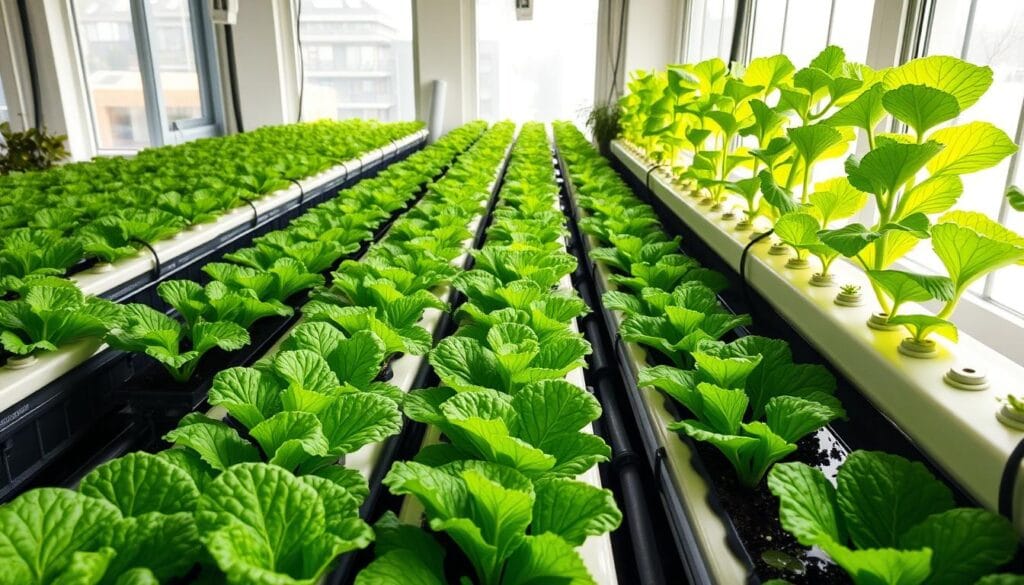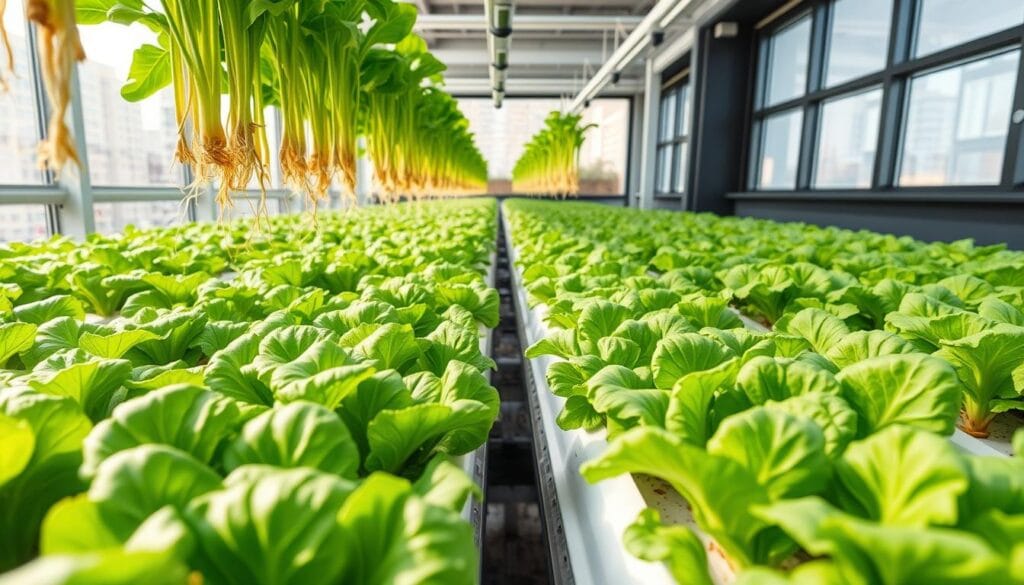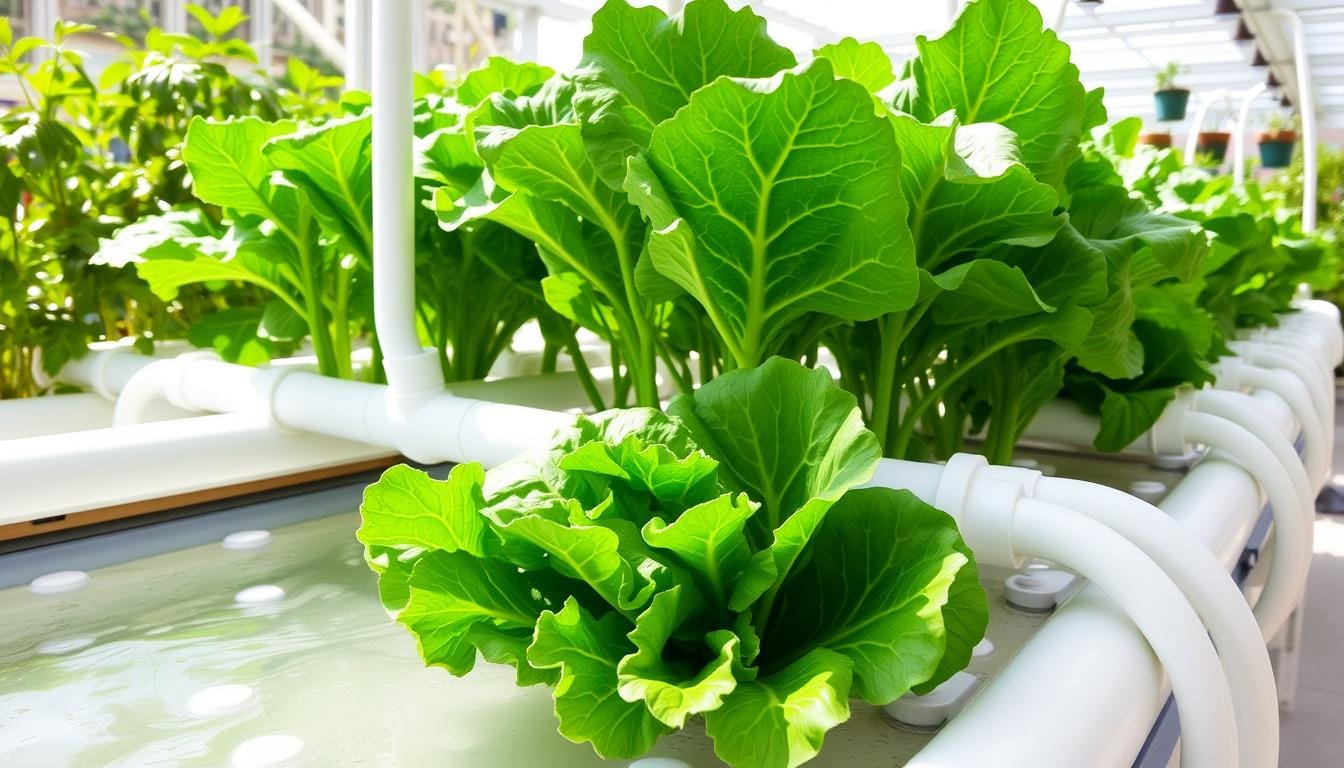Romaine lettuce hydroponic systems offer an easy way to grow fresh, crisp lettuce right in your home. Looking out your kitchen window, you might wish for fresh greens. Hydroponic systems make this dream come true by letting you grow nutrient-rich romaine lettuce indoors. These tips will help you grow a lot of lettuce, even if you’re new to gardening.
Key Takeaways
- Hydroponic systems enable year-round access to fresh, nutrient-dense romaine lettuce
- Romaine lettuce is perfect for hydroponic farming, reaching maturity within 4 to 6 weeks
- The ideal temperature range for growing hydroponic lettuce is between 60°F and 70°F
- Lighting should be provided for at least 10-12 hours per day
- Nutrient solution should be changed every 1-2 weeks for optimal growth
Understanding Hydroponic Lettuce Cultivation Basics
Hydroponic lettuce cultivation is a soil-free way to grow leafy greens. It employs nutrient-rich water solutions rather than soil. This method offers a controlled environment for better growth and yield.
Benefits of Soilless Growing Methods
Hydroponic lettuce cultivation has many benefits over traditional soil-based growing. It allows for faster growth, higher yields, and year-round production. Leafy greens like romaine lettuce do well in these controlled environments, thanks to nutrient-rich solutions.
Essential Components of a Hydroponic System
A typical hydroponic system for lettuce includes a few key parts. These are a container or growing tray, a soil-less medium, a flow system, and LED grow lights. These elements help create an optimal environment for leafy greens.
Why Choose Romaine Lettuce for Hydroponics
Romaine lettuce is a top choice for hydroponics because of its adaptability and nutritional value. It grows fast, reaching maturity in 3-4 weeks. It’s also rich in vitamins and minerals, making it great for a balanced diet. Its resilience and versatility make it perfect for controlled environment agriculture systems.
“Hydroponic lettuce farming eliminates the need for soil, facilitating more accurate and efficient delivery of nutrients to the plants.”
Setting Up Your Indoor Growing Environment
Starting your own vertical farming and sustainable food production at home is thrilling. The initial step toward success is creating an optimal indoor growing environment. When setting up your hydroponic system for romaine lettuce, pick a spot with the best conditions for growth.
For your romaine lettuce to grow well, find a place with plenty of light. Aim for about 6 hours of bright sunlight each day. The temperature should be between 65-75°F, and the humidity should be 40-60%. It’s also important to have good ventilation and easy access to water.
- Embrace vertical farming techniques to make the most of your space and increase production.
- LED grow lights are a great choice for the right light in your indoor setup.
- Smart countertop systems and grow towers are perfect for new hydroponic growers.
- Keep your growing area clean and sanitized to avoid pests and diseases.
By creating the perfect indoor conditions, you’ll be on your way to growing a lot of fresh, healthy romaine lettuce at home.
| Factor | Optimal Range |
|---|---|
| Lighting | 6 hours of bright sunlight per day |
| Temperature | 65-75°F |
| Humidity | 40-60% |
Essential Equipment for Romaine Lettuce Hydroponic Systems
Starting an indoor farm or controlled environment agriculture needs the right tools. You’ll need lighting, temperature control, and water circulation for your romaine lettuce. Each part is key to growing healthy leafy greens.
Lighting Requirements and Solutions
Romaine lettuce needs 10-14 hours of light each day. LED grow lights are a great choice because they save energy and give the right light. Adjust the light to match your lettuce’s growth stages for the best results.
Temperature Control Systems
Keeping the temperature between 65-75°F is vital for your lettuce. Use a thermostat and fans to control the temperature. This keeps your lettuce stress-free and helps it grow well.
Water Circulation Components
A recirculating system saves water and nutrients. Get water pumps, air stones, and pipes for a closed-loop system. This setup cuts down water use and keeps nutrients balanced, leading to healthy lettuce.
Also, think about adding systems to monitor temperature, humidity, and nutrients. This ensures your hydroponic setup works well. With the right equipment, your indoor romaine lettuce garden will thrive, giving you a bountiful harvest.
Selecting the Right-Growing Medium
Choosing the right growing medium is key for growing romaine lettuce hydroponically. Soilless methods are better for the environment and give you more control. Here are some top options for growing mediums that will help you grow lots of healthy lettuce.
- Rockwool, crafted from volcanic rock and chalk, provides excellent support for seedlings and root systemsand easily allows nutrients and water to enter.
- Phenolic Foam: This material is light and porous, perfect for hydroponics. It keeps moisture in and lets roots breathe.
- Coconut Fiber: Known as coco coir, it’s made from coconut husks. It retains water effectively and promotes root growth.
- Perlite, a type of volcanic glass that expands when heated, is excellent for improving drainage and aeration. It’s perfect for growing lettuce hydroponically.
Think about the medium’s physical and chemical properties and its environmental impact. Choose mediums that support sustainable food production. This way, your hydroponic system can help make the world greener.
| Growing Medium | Moisture Retention | Aeration | Sustainability |
|---|---|---|---|
| Rockwool | High | Excellent | Moderate |
| Phenolic Foam | High | Good | Moderate |
| Coconut Fiber | Excellent | Good | High |
| Perlite | Moderate | Excellent | High |
By picking the right growing medium for your hydroponic romaine lettuce, you’ll enjoy the perks of soilless cultivation and sustainable food production.
Optimal Nutrient Solutions for Hydroponic Romaine
To grow a healthy hydroponic romaine lettuce crop, you need a balanced nutrient solution. Romaine lettuce, like other leafy greens, needs a lot of nutrients for growth.
Primary Nutrient Requirements
The main nutrients for hydroponic romaine lettuce are nitrogen (N), phosphorus (P), and potassium (K). An ideal N-P-K ratio for optimal growth is 8-15-36. Seedlings need more nitrogen, at 10-5-15. Pre-harvest plants do well with 6-10-30.
Adding calcium and magnesium is key for strong plants and nutrient use. The best electrical conductivity (EC) for hydroponic romaine is 1.2 – 1.8 mS/cm.
pH Balance and Monitoring
Keeping the pH right is vital for nutrient use. The best pH for hydroponic romaine lettuce is 5.5 to 6.5. Test and adjust the pH often to help your plants absorb nutrients well.
Solution Maintenance Schedule
To keep your hydroponic romaine lettuce healthy, change the nutrient solution every 2-3 weeks. This stops mineral buildup and keeps nutrients balanced. Check the EC and pH weekly and adjust as needed to keep growing conditions perfect.
| Growth Stage | N-P-K Ratio | EC Range (mS/cm) |
|---|---|---|
| Seedling | 10-5-15 | 1.2 – 1.6 |
| Vegetative | 8-15-36 | 1.4 – 1.8 |
| Pre-Harvest | 6-10-30 | 1.2 – 1.6 |
“Maintaining the right nutrient balance and pH is crucial for growing healthy, high-yielding hydroponic romaine lettuce.”
Germination and Seedling Care
Growing romaine lettuce indoors or without soil needs careful germination and seedling care. Start by germinating seeds in a moist medium at 65-75°F. This setup can lead to a 75% germination rate.
When seedlings grow to 2 inches or have a few mature leaves, it’s time to move them. This usually happens in 2-3 weeks. Be gentle when transplanting to protect their roots. Make sure they get enough light and nutrients for growth.
| Germination Requirements | Seedling Transplant Guidelines |
|---|---|
|
|
By following these steps, you’ll grow healthy romaine lettuce indoors. This is great for soilless cultivation in your hydroponic system.

Maintaining Perfect Growing Conditions
Growing high-quality romaine lettuce indoors needs careful attention. You must focus on light, temperature, and humidity. These factors are key to the plant’s health and good yields.
Light Exposure Management
Romaine lettuce does best with 10-14 hours of light a day. Use the right lighting to meet this need. Adjust the light’s intensity and time as the plant grows.
Good lighting helps with photosynthesis. It also affects the lettuce’s size, texture, and nutrients.
Temperature and Humidity Control
Temperature and humidity are crucial for growing romaine lettuce indoors. Keep day temperatures at 68-75°F and nights at 60-65°F. Humidity should be between 40-60% to avoid mold or disease.
Controlling these factors is essential for healthy plants. It helps you get the best results from your controlled environment agriculture.
By managing light, temperature, and humidity, you create the best conditions for your lettuce. Keep an eye on these factors as your plants grow. This ensures the plants receive the essential nutrients they need to flourish.
Common Challenges and Solutions in Romaine Lettuce Hydroponic
Growing romaine lettuce hydroponically is rewarding but comes with challenges. As you start your journey in sustainable food production, be ready to face common issues in your hydroponic system.
Nutrient deficiencies are a big concern. Look for yellow leaves, stunted growth, or other signs of nutrient imbalances. Adjust your nutrient solution quickly to keep your lettuce healthy.
Pests can also be a problem. Use beneficial insects or organic pesticides to fight infestations. Keeping your system clean is key to preventing diseases.
Managing temperature and humidity is another challenge. Watch for signs like tip burn, bolting, and root rot. Adjust your growing conditions to solve these problems. Finding the right balance in light, water, and nutrients is crucial.
Stay alert, tackle challenges early, and keep improving your system. This way, you can enjoy a rich harvest of fresh, healthy romaine lettuce from your home.

| Common Challenges | Solutions |
|---|---|
| Nutrient Deficiencies |
|
| Pests and Diseases |
|
| Environmental Factors |
|
By tackling these common challenges with the right strategies, you can create a thriving hydroponic romaine lettuce system. Enjoy the benefits of sustainable food production right at home.
Harvesting Techniques and Best Practices
Timing is key when harvesting romaine lettuce grown hydroponically. It’s ready to pick 3-4 weeks after transplanting. You can harvest by either trimming the outer leaves or removing the entire head.
To keep your lettuce supply going, plant at different times. This way, you’ll always have fresh lettuce ready to eat.
Timing Your Harvest
Romaine lettuce is best when it’s 6-8 inches tall. The leaves should be crisp and green. Don’t let it bolt, as it can become bitter.
Storage Methods
Keep your lettuce fresh by wrapping it in a damp paper towel. You can also store it in water. For the best flavor, consume it within a week.
By following these tips, you’ll have plenty of fresh, tasty romaine lettuce. A little care goes a long way in your hydroponic garden!
Maximizing Yield Through Proper System Maintenance
Keeping your hydroponic system in top shape is key to getting lots of romaine lettuce. Clean and sanitize all parts regularly to stop algae and diseases. It’s also important to check and adjust the water’s nutrients, pH, and electrical conductivity (EC) for your plants’ best health.
Don’t forget about pruning and managing your plants. Trimming off overgrown or damaged leaves helps with airflow and keeps plants from getting too crowded. Using crop rotation or intercropping can also make the most of your space and nutrients.
Keeping track of your growth, harvests, and system changes helps you get better at vertical farming or controlled environment agriculture. By learning from your experiences and tweaking your methods, you can get the most out of your hydroponic romaine lettuce system. This way, you can enjoy plenty of harvests all year round.
- Regularly clean and sanitize all system components to prevent algae growth and disease.
- Monitor and maintain proper nutrient levels, pH, and electrical conductivity (EC) for optimal plant health.
- Prune plants as needed to promote air circulation and prevent overcrowding.
- Implement crop rotation or intercropping techniques to optimize space and nutrient usage.
- Keep detailed records of growth cycles, harvests, and system adjustments for continuous improvement.
| Maintenance Task | Frequency | Importance |
|---|---|---|
| Clean and sanitize system | Monthly | Prevents algae and disease |
| Monitor and adjust nutrients | Weekly | Ensures optimal plant nutrition |
| Prune and thin plants | Bi-weekly | Promotes air flow and growth |
| Rotate or intercrop | Per crop cycle | Optimizes space and nutrients |
| Record system data | Continuous | Enables continuous improvement |
By taking good care of your hydroponic system, you can make the most of your vertical farming or controlled environment agriculture setup. This way, you can always have plenty of fresh romaine lettuce.
Conclusion
Hydroponic romaine lettuce is a great way to grow food all year, even with little space. By following the tips in this guide, you can grow lots of tasty, healthy romaine lettuce. This method is both sustainable and efficient.
Hydroponic systems are perfect for growing your food, no matter where you live or the weather. With the right care, you can make the most of growing romaine lettuce. This helps make our food system better and lets you enjoy your harvest.
Whether you’re new to growing food indoors or have been doing it for a while, this guide can help. By learning about the key parts, how to manage nutrients, and how to control the environment, you can grow delicious romaine lettuce all year. You can easily achieve this in the comfort of your own home.

